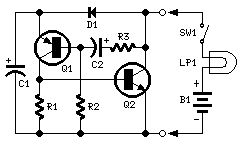Two-wire Lamp Flasher Circuit
Ideal to operate 3 to 24V DC existing on-circuit lamps
LED operation is also possible
Parts:
R1 6K8 1/4W Resistor
R2 270K 1/4W Resistor
R3 22K 1/4W Resistor
C1 220�F 25V Electrolytic Capacitor
C2 10�F 25V Electrolytic Capacitor
D1 1N4002 100V 1A Diode
Q1 BC557 45V 100mA PNP Transistor
Q2 BD139 80V 1.5A NPN Transistor
LP1 Existing filament Lamp: any type in the range 3-24V 10W max.
SW1 Existing On-Off switch
B1 Existing V DC source: any type in the range 3-24V
suited to the lamp adopted
Device purpose:
This circuit has been designed to provide that continuous light lamps already wired into a circuit, become flashing. Simply insert the circuit between existing lamp and negative supply.
Especially suited for car or panel pilot lights, this device can drive lamps up to 10W.
Notes:
Break lamp(s) to negative supply connection(s), then insert the circuit between existing lamp(s) connection(s) and negative supply (respecting polarities!).
C1 value can be varied from 100 to 1000�F or higher, in order to change flashing frequency.
Although rather oversized, this circuit can also drive any LED, providing a suitable resistor is fitted in series with the light emitting device.
The resistor should be in the range 47R to 2K2, depending on supply voltag
author:RED Free Circuit Designs,
website: http://www.redcircuits.com/

